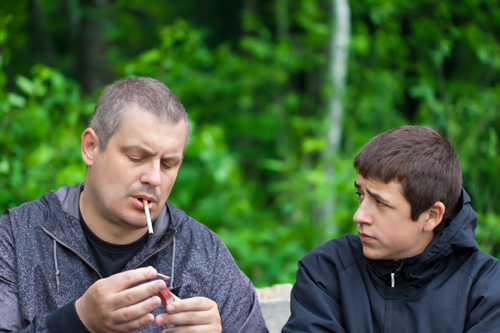 It is well known that smoking cigarettes harms nearly every organ in the body. Yet, over 16 million Americans are living with a smoking-related disease. In the U.S., over 480,000 deaths every year are linked to cigarette smoking, including about 42,000 deaths from exposure to secondhand smoke.
It is well known that smoking cigarettes harms nearly every organ in the body. Yet, over 16 million Americans are living with a smoking-related disease. In the U.S., over 480,000 deaths every year are linked to cigarette smoking, including about 42,000 deaths from exposure to secondhand smoke.
There are laws that ban smoking in public places. In 26 states and the District of Columbia, the implemented smoke-free law prohibits smoking at all work sites and indoor public facilities such as bars and restaurants.
That being said, researchers from the U.S. Centers for Disease Control and Prevention found that about half of teens in the U.S. who have never smoked tobacco, are at risk of secondhand smoke (including in the family home or in the car). The new study was published early online in the advanced February issue of the journal Pediatrics.
“These findings are concerning because the U.S. Surgeon General has concluded that there is no safe level of secondhand smoke exposure,” explained lead study author Israel Agaku, a researcher at the CDC.
For the study, the researchers examined data from 18,406 students from middle schools and high schools. For students from grades six to 12, 48% had reported secondhand smoke exposure in the 2013 National Youth Tobacco Survey within the past seven days before the study. Also, the students without smoke-free rules in the home or car reported nine times the secondhand smoke exposure when compared to teens with 100% smoke-free rules.
In the study, the CDC research team found that 15.5% of subjects were exposed to secondhand smoke in the home and 14.7% were exposed in a vehicle. In addition, the questionnaire revealed that 16.8% of the teens were exposed to secondhand smoke at school, 27.1% were exposed at work, and 35.2% were exposed in an outdoor or indoor public place.
The secondhand smoke exposure assessed was based on smoke-free protection policy laws, and the states with those policies had students with the least secondhand smoke exposure.
When it came to exposure to secondhand smoke in vehicles or at home, study author Brian King noted that individual families must take action to prevent the exposure. King is the deputy director for research translation at the CDC’s Office on Smoking and Health.
There are several diseases linked with secondhand smoke, including about 7,300 lung cancer deaths in the U.S. Evidence also links secondhand smoke to other cancers such as breast, stomach, rectum, bladder, brain, nasal sinuses, throat, and larynx. Secondhand smoke is also thought to increase heart disease by 25% to 30%. It may also lead to depression, poor immunity, ear infections, coughing, wheezing, shortness of breath, and lung infections like pneumonia and bronchitis.
In another study published in the journal Archives of Otolaryngology – Head & Neck Surgery in 2011, NYU School of Medicine researchers found that tobacco smoke exposure from secondhand smoke nearly doubles the hearing loss risk in adolescents.
In general, it is necessary to prevent the number of teenage smokers. The CDC has previously reported that about 23% of high school students use tobacco products with 90% of those smoking cigars, pipes, hookahs, or cigarettes. Nine out of 10 smokers will smoke their first cigarette by at least 18-years-old. Over 3,800 teens aged 18 years or younger will smoke their first cigarette every day in the U.S. Another 2,100 American youth will become addicted to smoking.
